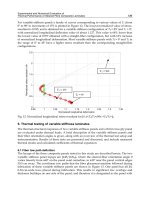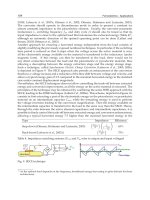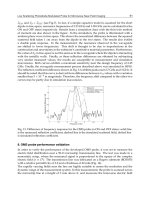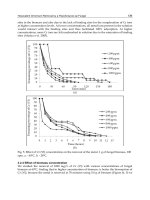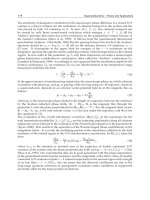Differential Equations and Their Applications Part 6 ppt
Bạn đang xem bản rút gọn của tài liệu. Xem và tải ngay bản đầy đủ của tài liệu tại đây (667.09 KB, 20 trang )
90 Chapter 4. Four Step Scheme
hold:
Y(t) t 9 [o,
O(X(t)),
(3.3)
Z(t) a(X(t),O(X(t)))XO~(X(t)),
then we call (X,
Y, Z) a nodal solution
of (3.1), with the
representing func-
tion O.
Let us now make some assumptions.
(H1) The functions a, b, h are C 1 with bounded partial derivatives and
there exist constants A, # > 0, and some continuous increasing function
u: [0, oc) + [0, cx)), such that
(3.4)
AI <_ a(x,y)a(x,y) T <_ #I, (x,y) 9 4 n • 4,
(3.5)
Ib(x,y)[ ~
u(ly[),
(x,y) 9 4 ~ x 4,
(3.6) inf
h(x)
_= 5 > 0, sup
h(x) - 7 < ~z.
xEl~ ~ xERn
The following result plays an important role below.
Lemma 3.2.
Let (H1) hold. Then
the
following equation admits a classical
solution 0 9
C2+~(4n):
(3.7)
~tr(O~a(x,O)aX(x,O))
such that
+ ( b(x, 0), O~ ) -h(x)O
+ 1 = 0, x 9 4 ~.
1 1
(3.8)
- < O(x) < ~, x 9 4 ~.
Sketch of the proof.
Let
BR(O)
be the ball of radius R > 0 centered
at the origin. We consider the equation (3.7) in BR(0) with the homo-
geneous Dirichlet boundary condition. By [Gilbarg-Trudinger, Theorem
14.10], there exists a solution O R E C2+~(BR(0)) for some a > 0. By the
maximum principle, we have
(3.9)
0 <_ On(x) < ~, x C Bn(O).
Next, for any fixed x0 E 4 n, and R > [xo] + 2, by Gilbarg-Trudinger [1,
Theorem 14.6], we have
(3.10)
[Off(x)l
_~ C, x 9 Bl(X0) ,
where the constant C is independent of R > Ix0[ + 2. This, together with
the boundedness of a and the first partial derivatives of a, b, h, implies
that as a linear equation in 0 (regarding
a(x, O(x))
and
b(x, O(x)) as
known
w Infinite horizon case 91
functions), the coefficients are bounded in C 1 . Hence, by Schauder's interior
estimates, we obtain that
(3.11) 118Rllc2+~(Bl(x0)) < C, VR > Ix01 + 2.
Then, we can let R + co along some sequence to get a limit function 8(x).
By the standard diagonalization argument, we may assume that 8 is defined
in the whole of ~'~. Clearly, 8'E Ce+~(~ '~) and is a classical solution of
(3.7). Finally, by the maximum principle again, we obtain (3.8). []
Now, we come up with the following existence of nodal solutions to
(3.1). This result is essentially the infinite horizon version of the Four Step
Scheme presented in the previous sections.
Theorem 3.3.
Let (H1) hold. Then there exists at least one nodal solu-
tion
(X,
Y, Z) of (3.1), with the representing function 8 being the solution
of (3.7). Conversely, if
(X,
]I, Z) is a nodal solution of (3.1) with
the
repre-
senting function 8. Then 8 is a solution of (3.7).
Proof.
By Lemma 3.2, we can find a classical solution 8 E C2+~(~ n)
of (3.7). Now, we consider the following (forward) SDE:
(3.12)
~ dX(t) = b(X(t), 8(X(t)))dt + a(X(t), 8(X(t)))dW(t), t > O,
(
x(o) = x.
Since 8~ is bounded and b and a are uniformly Lipschitz, (3.12) admits
a unique strong solution
X(t), t E
[0, co). Next, we define Y(-) and Z(.)
by (3.3). Then, by Ith's formula, we see immediately that (X, Y, Z) is an
adapted solution of (3.1). By Definition 3.1, it is a nodal solution of (3.1).
Conversely, let (X, ]I, Z) be a nodal solution of (3.1) with the represent-
ing function 8. Since 8 is C 2, we can apply It6's formula to
Y(t) = 8(X(t)).
This leads to that
dY(t)
= [(b(X(t),
8(X(t))), 8,(X(t))
>
(3.13)
+ ~tr (8~(X(t))aaq-(X(t),8(X(t))))]dt
+ (8~(X(t)), a(X(t), 8(X(t)))dW(t) ).
Comparing (3.13) with (3.1) and noting that
Y(t) = 8(X(t)),
we obtain
that
(3.14)
< b(x(t),
8(x(t))),
(x(t)) > +
T (x(t),
8(x(t)))]
= h(X(t))8(X(t))
- 1, Vt > 0, P-a.s.
Define a continuous function F : ~n _+ ]R by
F(x) A=
(
b(x, 8(x)), 8x (x) ) +
ltr [Sxx
(x)aa T (x,
8(x))]
(3.15)
- h(x)8(x) + 1.
92 Chapter 4. Four Step Scheme
We shall prove that F _= 0. In fact, process X actually satisfies the following
FSDE
f dX(t) = b(X(t))dt + ~(X(t))dW(t),
(3.16)
X0~x,
t_>0;
where b(x) ~b(x,O(x)) and ~(x) ~a(x,0(x)). Therefore, X is a time-
homogeneous Markov process with some transition probability density
p(t,x,y).
Since both b and ~ are bounded and satisfy a Lipschitz con-
dition; and since ~__A aa T is uniformly positive definite, it is well known
(see, for example, Friedman [1,2]) that for each
y 9 ~n, p(.,. ,y)
is the
fundamental solution of the following parabolic PDE:
1 02; + 0p _ 0,
(3.17) ~
OxiOxj Ot
i,j~l i~- i
and it is positive everywhere. Now by (3.14), we have that
F(X(t))
= 0 for
all t ~ 0, P-a.s., whence
(3.18)
0 = Eo,~ [F(X(t)) 2] =/Ft p(t,x,y)F(y)2dy, Vt > O.
By the positivity of
p(t, x,
y), we have
F(y)
= 0 almost everywhere under
the Lebesgue measure in IRn. The result then follows from the continuity
of F. []
Theorem 3.3 tells us that if (3.7) has multiple solutions, we have the
non-uniqueness of the nodal solutions (and hence the non-uniqueness of the
adapted solutions) to (3.1); and the number of the nodal solutions will be
exactly the same as that of the solutions to (3.7). However, if the solution
of (3.7) is unique, then the nodal solution of (3.1) will be unique as well.
Note that we are not claiming the uniqueness of adapted solutions to (3.1).
w Uniqueness of
nodal solutions
In this subsection we study the uniqueness of the nodal solutions to (3.1).
We first consider the one dimensional case, that is, when X and Y are
both one-dimensional processes. However, the Brownian motion
W(t)
is
still d-dimensional (d > 1). For simplicity, we denote
1
(3.19)
a(x,y) = -~la(x,y)l 2, (x,y) 9 ~2.
Let us make the some further assumptions:
(H2) Let m n = 1 and the functions a, b, h satisfy the following:
(3.20)
h(x)
is strictly increasing in x E ~.
w Infinite horizon case
93
(3.21)
/0 1
a(x,y)h(x) - (h(x)y -
1)./n
ay(x,y + ~(~-y))d~ >_ ~1 > O,
1
[a(x,y)by(x,y + t3(~
-
y))
-%(x,y +13(~-y))b(x,y)]dt3 >_ O,
y,~E[1,89149
Condition (3.21) essentially says that the coefficients b, a and h should
be somewhat "compatible." Although a little complicated, (3.21) is still
quite explicit and not hard to verify. For example, a sufficient conditions
for (3.21) is
a(x,y)h(x) - (h(x)y - 1)av(x,w ) > ~ > O,
(3.22)
a(x, y)by(x, w) - ay(x, w)b(x, y) >_
0,
It is readily seen that the following will guarantee (3.22) (if (H1) is as-
sumed):
(3.23)
ay(x,y)
= 0,
by(x,y) >_ O,
(x,y) e ]R x [1, 89
In particular, if both a and b are independent of y, then (3.21) holds auto-
matically.
Our main result of this subsection is the following uniqueness theorem.
Theorem 3.4.
Let (H1)-(H2) hold. Then (3.1) has
a unique
adapted
solution. Moreover, this solution is nodal.
To prove the above result, we need several lemmas.
Lemma 3.5. Let h be
strictly increasing and 0 solves
(3.24)
a(x, 0)0~ + b(x, 0)0~ - h(x)O + 1 = O, x e ~.
Suppose XM is a local maximum of O and Xm is a locM minimum of O with
O(Xm) ~ O(XM).
Then Xm >
XM.
Proof.
Since h is strictly increasing, from (3.24) we see that 0 is not
identically constant in any interval. Therefore xm r
XM.
Now, let us look
at
XM.
It is clear that
O~(XM) = 0
and
O~(XM) < O.
Thus, from (3.24) we
obtain that
1
(3.25)
9(XM) <_ h(xM ~"
Similarly, we have
1
(3.26)
O(xm) >_
h(xm)"
Since
O(xm) <_ O(XM),
we have
1 1
(3.27) <
h(xm) h(XM) '
94 Chapter 4. Four Step Scheme
whence x M < Xm
because
h(x)
is strictly increasing. []
Lemma 3.{}.
Let (H1)-(H2) hold. Then (3.24) admits
a unique
solution.
Proof.
By Lemma 3.2 we know that (3.24) admits at lease one classical
solution 8. We first show that 8 is monotone decreasing. Suppose not,
assume that it has a local minimum at xm. Since 8 E C 1 and 8 is not
constant on any interval as we pointed out before, 8~ > 0 near
Xm.
Using
Lemma 3.5, one further concludes that 8~ > 0 over
(Xm, cx3).
In other
words, 8 is monotone increasing on (xm, co). The boundedness of 8 then
leads to that lim~_~ 8(x) exists.
Next we show that
(3.28) lira 8~(x) = lira
8zz(x) = O,
X '~ C:X:~ X +CX)
To see this, we first apply Taylor's formula and use the boundedness of 8x~
to conclude that there exists M > 0 such that for any x C (xm, o0) and
h>0
8(x + h) - 8(x) - Mh 2 < 8x(x)h < 8(x + h) - 8(x) + Mh 2.
Since lim~_~ 8(x + h) - 8(x) = 0, we have
-Mh 2<
lim
8~(x)h < ~ 8~(x)h < Mh 2.
Dividing h and letting h + 0 we derive lim~-~oo 8~(x) = 0. Further, note
that
1
8~ - a(x,8~[-b(x,8)Sx + h(x)8 -
1].
The boundedness of 8, 8~, and 8~z and the assumption (H1) then show that
8xz~ exists and is continuous and bounded as well. Thus apply Taylor's
expansion to the third order and repeat the discussion above one shows
further that limz-~oo 8~z(x) = 0 as well, proving (3.28). Consequently, by
(3.24) we have
1
(3.29) lim 8(x)=
9 ~ h(+cr "
On the other hand, by (3.20), we see that
1 1
(3.30) lim 8(x) >
8(Xm) > >
9 -+~ - h(xm) h(+cr
which contradicts (3.29). This means that 8 has no local minimum. Sim-
ilarly one shows that 8 can not have any local maximum either, hence it
must be monotone on ~. Finally, since
1 1
(3.31) ~(-cr h(-cx3 ~ > h(+cr -8(+cr
it is necessary that 8 is monotone decreasing.
w Infinite horizon case 95
Next, let 0 and 0"be two solutions of (3.24). Then, w = 0"- 0 satisfies
(3.32)
(h(x) - ~01 [ay(x,O -b t~W)Oxx -[-by(x,O § ~?.o)Ox]dl~)w
where
~o 1
c(x) = h(x) - [ay(x,O § ~w) h(x)9 - 1 - b(x,O)9~
a(x, e)
+ by(x, e + Zw)e~]dZ
a(x,9)h(x) - (h(x)9 -
1)
f3 ay(x,9 + j3(O- 9))48
(3.33) =
a(x,e)
10~ I [a(x,
O)by(x, 0 + ~(~-
0))
+
ay(x,130 + t3('0- O) )b(x,O)] dl3 >_
~_.
#
Here, we have used the fact that
O~(x) = -IO~(x)l
(since 0 is decreasing
in x) and (3.21) as well as (3.7). From (H1), we also see that
a(x, "0) >_ 0
and b(x,'O)
are bounded. Thus, by the lemma that will be proved below,
we obtain w = 0, proving the uniqueness. []
Lemma 3.7.
Let w be a bounded classical solution of the following equa-
tion:
(3.34)
5(x)wx~ + b(x)w~ - c(x)w =
0, x e R,
with c(x) > co > O, ~(x) >_ O, x C IR ~, and with 5 and b bounded. Then
w(x) = o.
Proof.
For any a > 0, let us consider ~(x)
w(x) -
a[xl 2. Since w
is bounded, there exists some x~ at which ~ attains its global maximum.
Thus, ~(x~) = 0 and ~"tx~ ~j~ _< 0, which means that
(3.35) ~(~) = 2~x~,
~(~.) <
2~.
Now, by (3.34),
(3.36)
<
2.(a(x.) + k~.)~.).
For any x C IR, by the definition of x~, we have (note the boundedness of
5 and b)
~(x) - ~lxl ~ < ~(x~) - ~1~1 ~
(3.37)
< ~- (23(~.) + 2~(~.)~. -I~.l :) _< C~.
co-
96 Chapter 4. Four Step Scheme
Sending a + 0, we obtain
w(x) <_ O.
Similarly, we can show that
w(x) > O.
Thus
w(x) =__ O. []
Proof of Theorem 3.4.
Let (X, Y, Z) be any adapted solution of (3.1).
Under (H1)-(H2), by Lemma
3.6,
equation
(3.24)
admits a unique classical
solution 0 with 0x _< 0. We set
(3.38)
{~(t) 9 [0, oo).
O(X(t)),
t
Z(t) a(X(t),O(X(t)))VO~(X(t)),
By ItS's formula, we have (note (3.19))
(3.39)
d~(t)
[-
]
= [0~ (X(t))b(X(t), Y(t)) + 0~ (X(t))a(X(t),
Y(t))]
dt
+ (a(X(t), Y(t))VOx(X(t)), dW(t) ).
Hence, with (3.1), we obtain (note (3.24)) that for any 0 _< r < t < 0%
(3.40)
ElY(r) - Y(r)] 2 - ElY(t) - Y(t)] 2
= -E ff {2[Y-
Y][Ox(X)b(X,Y)+ Ozz(X)a(X,Y)
-h(X)Y +
1] +
la(X,Y)Ox(X)- Z[2}ds
<
-2E ft[~ _ Y] [0~(x)(b(X,
Y) - b(X, f~))
+ Oxx (X) (a(X, Y) - a(X, Y)) - h(X)(Y -
Y)]
ds
=-2E ff {[:~-
Y]2[IO~(X)I
folby(X,P + ~(Y- P))d~
-Ox~(X) fool ay(X,Y + ~(Y- Y))d~ +
h(X)]
}ds
= -2E frr t c(s)l~'(s ) -
Y(s)lUds,
w Infinite horizon case 97
where (note the equation (3.24))
/o 1
c(s) = h(X)
+ IO.(X)I by(X, ~ + ~(Y - ~))d~
b(x,~)o~(x) - h(x)~ + 1
+
a(x,
#)
9 ay(X, Y + t3(Y - ~'))&3
1
(3.41) - a(X, Y) {a(X, Y)h(X)
- [h(X)Y -
1]
.~1 ay(X,F" + ~(Y
Y))dfl
+ IOx (X)] [a(X, Y)by (X, Y + fl(Y - Y))
- b(X,Y)ay(X,Y" +/3(Y - Y))] d/3 >_
_~.
J
#
Denote ~o(t) = ElY(t)-Y(t)] 2 and a = ~ > 0. Then (3.40) can be written
It
a8
~o(r) _< ~o(t) - a ~(s)ds, 0 < r < t < oo.
(3.42)
Thus,
,
(3.43) f ~(s)ds) , = e_a t _ t
> r t e [r, oo).
Integrating it over Jr, T], we obtain (note Y and Y" are bounded, and so is
~)
e-C~r _ e-aT f T
(3.44)
a (fl(r) ~ e-aT I ~fl(s)ds < CTe -c'T, T > O.
a 7,
Therefore, sending T -~ cx~, we see that 9~(r) = 0. This implies that
(3.45) Y(r) = Y(r) =_ O(X(r)), r E [0, co), a.s. co 9 f~.
Consequently, from the second equality in (3.40), one has
(3.46) Z(s) = Z(s) = a(X(s),O(X(s)))To,(X(s)), Vs 9 [0,~).
Hence, (X, Y, Z) is a nodal solution. Finally, suppose (X, Y, Z) and
A A
(X,Y, Z) are any adapted solutions of (3.1). Then, by the above proof,
we must have
(3.47) Y(t) = O(X(t)), ~'(t) = O(X(t)), t 9 [0, oo).
98
Chapter 4. Four Step Scheme
Thus, by (3.1), we see that X(-) and )((.) satisfy the same forward SDE
with the same initial condition (see (3.12)). By the uniqueness of the strong
solution to such an SDE, X = )(. Consequently, Y = Y and Z = Z. This
proves the theorem. []
Let us indicate an obvious extension of Theorem 3.4 to higher dimen-
sions.
Theorem 3.8.
Let (HI) hold and suppose
there
exists a solution 0 to (3.7)
satisfying
(3.48)
L
1
a v (x, (1 -
13)O(x) + 130)0~.~i (x)
i,j=l
n
- E biu(x, (1 -~)O(x)
+ ~O)O~,(x)]d~ > ~ > O,
i:1
Then (3.1) has a unique adapted solution. Moreover, this solution is nodal
with 0 being the representing function.
Sketch of the proof.
First of all, by an equality similar to (3.32), we
can prove that (3.7) has no other solution except
O(x).
Then, by a proof
similar to that of Theorem 3.4, we obtain the conclusion here. []
Corollary 3.9.
Let (H1) hold and both a and b be independent of y. Then
(3.1) has a unique adapted solution and it is nodal.
Proof.
In the present case, condition (3.48) trivially holds. Thus, The-
orem 3.8 applies. []
w The limit of finite duration problems
In this subsection, we will prove the following result, which gives a rela-
tionship between the FBSDEs in finite and infinite time durations.
Theorem 3.10.
Let (H1)-(H2) hold and let 0 be a solution of (3.7) with
the property (3.48). Let (X, Y, Z) be the nodal solution of (3.1) with the
representing function O, and
(X K,
yg,
zK)
C
J~[0, K]
be the adapted
solution of (3.1) with
[0, ~)
replaced by
[0, K],
and YK ( K) = g( X ( K ) ) for
some bounded smooth function g. Then
(3.49) lim
E{fxK(t) X(t)]z+[Yg(t) Y(t)I2+EIZK(t) Z(t)] z} = O,
K , + oo
uniformly in t on any compact sets.
To prove the above result, we need the following lemma.
w Infinite horizon case 99
Lemma 3.11.
Suppose that
(3.50)
{ AI < (aiJ(t,x)) < ItI,
Ibi(t,x)l < C,
l<i<n,
c(t, x) >_ n > o,
I~o(~)1 _< M,
(t, z) 9 [0, o0) • Rn
with some positive constants
A,
It, ~?, C and M. Let w be the classical solu-
tion of the following equation:
(3.51)
i n
wt- ~ aiJ(t,x)w~j- Ebi(t,x)w~, +c(t,x)w=O,
ij-~l i=l
(t, x) 9 [o, ~1 •
~,
Then
(3.52)
Iw(t,z)l
<_
Me -nt,
(t,x) 9 [0, c~) x An.
Proof.
First, let R > 0 and consider the following initial-boundary
value problem:
(3.53)
wtR- E aiJ(t'x)w~J- bi(t'x)wR~ +c(t'x)wn=O'
i,j=l
i=1
(t,x)[0,~)• 9 BR,
wR[oBR = O,
WR[t=O = Wo(x)xR(x),
where BR is the ball of radius R > 0 centered at 0 and
X R
is some "cut-
off" function. Then we know that (3.53) admits a unique classical solution
W R E
C2+a'l+al2(BR
• [0, OO))
for some a > 0, where C 2+a'1+~/2 is the
space of all functions
v(x, t)
which are C 2 in x and C 1 in t with H51der
continuous v,~s and
vt
of exponent a and
a12,
respectively. Moreover, we
have
(3.54)
IwR(t,x)l
< M, (t,x) e
[0,~) • BR,
and for any Xo C ~" and T > O, (0 < a' < a)
(3.55) w R -~ w,
in C 2A-~ ([0, T] x B 1 (xo)), as R ~ (20,
where w is the solution of (3.51). Now, we let r
x) = Me -(n-~)t (~ > 0).
100
Then
Chapter 4. Four Step Scheme
n
Ct - aiY(t,x)r - Ebi(t,x)r + c(t,x)r
i,j=l i=1
(3.56) = (c(t,
x) - ~ + e)M -(n-~)t > eM -(n-~)t > O,
r > o = wR]oB~,
r = M >_ wo(z) = wn]t=o .
Thus, by Friedman [1, Chapter 2, Theorem 16], we have
(3.57) wR(t,~) _ r =
M -('-~)~,
(t,~) ~ [0, o~) • BR.
Similarly, we can prove that
(3.58)
wn(t,x) > -Me -(n-~)t, (t,x) C
[0,0o) •
Bn.
Since the right hand sides of (3.57)-(3.58) are independent of R, we see
that
(3.59)
Iw(t,x)l <_ Me -('-~)t, (t,x) C
[0, oc) • ~n.
Hence, (3.52) follows by sending c + 0. []
Proof of Theorem 3.10.
By the result from w we know that
(X K, yg Z K)
satisfies
yK(t) = OK (t, xg(t)),
(3.60)
zK(t) = a(xK(t),oK(t, xK(t)))ToK(t, xK(t)),
t E [0, K], a.s. w C
ft,
where O K is the solution of the parabolic equation:
I oK ~_
aiJ(x, OK~K
b~(x, K K
J~x,xj + ~ O )Ox, - h(x)O K +
1= 0,
(3.61)
i,j=l i=1
(x, t) c ~ • [0, T),
with a = 89 Next, we define ~ to be the solution of
(3.62)
i,j=l
~l~=o = g(x)"
Clearly, we have
(3.63)
og(t,x) = ~(g - t,x),
- ~_~ bi(x, ~)~x~ + h(x)~ - 1 = O,
i~l
(t, x) e [0, ~) x ~n,
(t, x) e [o, K] • ~n.
w Infinite horizon case 101
Now, we
let
w(t, x) = ~o(t, x) - O(x).
Then
(3.64)
i,j=l
i=1
"aUi~ lbiy(X'O'Ju'w)Oxi)K']w:O'
~=o =
9(x) - O(x).
We note that both 99(x, t) and
O(x)
lie in [1, ~]. Thus, by condition (3.48)
and Lemma 3.11, we see that
(3.65)
1
IOK (t,x)
O(x)l
= I~o(K
-
t,x)
-
O(x)l
_< ~-,(K-*),
(t, x) e [0,/(] • ~n x [0, K], K > 0.
Now, we look at the following forward SDEs:
(3.66)
dXK(t) = b(X(t) K, oK(t, X(t)K))dt
+ a(X(t) K, O K (t, X(t)K))dW(t),
xK(o) = z.
dX(t) = b(X(t), O(X(t)))dt + a(X(t), O(X(t)))dW(t),
(3.67) X(0) = x.
By It6's formula, we have
EIXK(t) -
X(t)l 2
/o
=E [2(xK X,b(XK,OK(s, XK))-b(X,O(X)))
+ tr ([~(X K, 0K(s, xK)) ,,(X, O(X))].
[~(xK,o K(s,xK)) - ~(X,O(N))] T) ]~s
(3.68)
< CE [IN K - X I (IX K - X l + IOK(s, X K) - o(xK)I)
+ (Ix K
- xl + IOK(*,X K) - o(xK)l)2]a*
<
c fo' [EIXK(s)- X(8)12 + e-~,(K-s)] ds
/o
< C INK(s) - X(s)lNds + Ce -2"(K-t).
102 Chapter 4. Four Step Scheme
Applying Gronwall's inequality, we obtain that
(3.69) E
(IXK(t) - X(t)l 2) _<
Ce -2€
t 9
[0,K], K > 0.
Furthermore,
E (]yK(t)
Y(t)] 2)
= E (IOK(t, xK(t)) O(X(t))l 2)
_< 2E (J•K(t,
xK (t) ) o(xK (t) )I 2)
(3.70)
+ 2E
(lO(XK(t)) - O(X(t))l 2)
< ce -2~(~-') + CE
(IX~(t) - X(t)l 2)
< Ce -2~(K-t), t 9
[0, K], K > 0.
Similarly, we have
(3.71)
E (]ZK(t) -
Z(t)l 2) _<
Ce -2n(K-t),
Finally, letting K + 0o, the conclusion follows.
t c [o, K], K > O.
[]
Chapter 5
Linear Degenerate Backward Stochastic
Partial Differential Equations
w Formulation of the Problem
We note that in the previous chapter, all the coefficients b, a, h and g
are deterministic, i.e., they are all independent of w E f~. If one tries to
apply the Four Step Scheme to FBSDEs with random coefficients, i.e., b,
a, h and g are possibly depending on w E ~ explicitly, then it will lead
to the study of general degenerate nonlinear backward partial differential
equations (BSPDEs, for short). In this chapter, we restrict ourselves to the
study of the following linear BSPDE:
1 (ADu) (a, Du)-cu-V.(Bq) (b,q)-f}dt
-
(1.1)
+ ( q, dW(t)
), (t, x) e [0, T] x ~t n,
U]t=T g,
where
Du
is the gradient of u,
{
V-~ =
~__O,,~,,
V,~ = (,'~, ,&) e C1(~";~"),
i=l
V'r ~ (V'~]~I,''',V'~m)
T,
V(]~ -~- (~]~l,''',(~m)
E C l(F~n;~nxm),
and
A: [0, T] x ~n x ~ ). S '~,
]B: [0, T] x~ ~ x ~ ~ll~ ~xd,
~a : [0, T]
x ~n x ~ ~
~,
(1.2)
/ b: [O,T] x ~'~ x ~ ). ~d,
I
/ s :[o,T] x x
!
n
I,g:~
x~,
are random fields
(S n
is the set of all (n x n) symmetric matrices). We
assume that W = {W(t) : t E [0, T]} is a d-dimensional Brownian motion
defined on some complete filtered probability space (f~, ~, {~t}t>_o, P), with
{:~t}t>_0 being the natural filtration generated by W, augmented by all the
P-null sets in 5 r.
In our discussions, we will always assume that A and B are differen-
tiable in x. In such a case, (1.1) is equivalent to an equation of a general
form. To see this, we note that
(1.3) ~ tr
[AD2u] = ~7.(ADu) - ( V. A, Du );
L
tr
[BTDq]
= V-(Bq) - ( V-B, q),
104 Chapter 5. Linear, Degenerate BSPDEs
where
D2u
is the Hessian of u and
0x I
ql
Dq A=(Dql, ,Dqd) A .
Therefore, if we define
1
(1.4) ~ = a + ~ V. A;
then (1.1) is the same as
iii
/
9 "" Ox:qd]
b=b+V-B,
du
= { - ~tr
[AD2u] -
(5,
Du ) -cu -
tr
[BT Dq]
1
(1.5)
- (b,q) -f }dt + ( q, dW(t) ), (t,x) G [O,T] x ]R
n,
~tlt=T : g,
Since (1.1) and (1.5) are equivalent, all the results for (1.1) can be
automatically carried over to (1.5) and vice versa. For notational conve-
nience, we will concentrate on (1.1) for well-posedness (w167 and on (1.5)
for comparison theorems (w
Next, we introduce the following definition.
Definition 1.1. If A and B satisfy the following:
(1.6)
A(t, x) - B(t, x)B(t, x) T >_
0, a.e. (t, x) C [0, T] x IR '~, a.s.,
we say that equation (1.1) is
parabolic;
if there exists a constant 5 > 0, such
that
(1.7)
A(t, x) - B(t, x)B(t, x) T >_ 5I,
a.e. (t, x) C [0, T] x ]R n, a.s.
we say that (1.1) is
super-parabolic;
whereas, if (1.6) holds and there exists
a set G C_ [0, T] • IRn of positive Lebesgue measure, such that
(1.8) Get [A(t,
x) - B(t, x)B(t, x) T]
= 0, V(t, x) 9 G, a.s.
we say that (1.1) is
degenerate parabolic.
We see that in the above definition, only A and B are involved. Thus,
the above three notions are adopted to equation (1.5) as well.
Note that if (1.1) is super-parabolic, it is necessary that
A(t, x)
is uni-
formly positive definite, i.e.,
(1.9)
A(t,
x) > 6I > 0, a.e. (t, x) 9 [0, T] • Ill n, a.s.
However, if
A(t, x)
is uniformly positive definite and (1.6) holds, we do
not necessarily have the super-parabolicity of (1.1). As a matter of fact, if
A(t,x)
satisfies (1.9) and
(1.10)
A(t,x) = B(t,x)B(t,x) T,
a.e.
(t,x) 9
[0, T] x IR n, a.s.
w Formulation of the problem 105
then (1.1) is degenerate parabolic. This is the case if we have the BSPDE
from the Four Step Scheme for FBSDEs with random coefficients (see Chap-
ter 4, w
Now, we introduce the notion of solutions to (1.1). In what follows, we
denote
Bn = {x E ~n
I lxl < R} for any R > 0.
Definition 1.2. Let
{(u(t,x;w),q(t,x;w)),(t,x,w) C
[0,T] x R n • ft} be
a pair of random fields.
(i) (u, q) is called an
adapted classical solution
of (1.1) if
u E C~:([0, T]; L2(f~; C2(Bn))),
(1.11) VR > 0,
q e L~(0, T; CI(BR; ]Rd)),
such that almost surely the following holds for all (t, x) E [0, T] x IR~:
(1.12)
ft T 1 u(t,x) = g(x) + {-~ V.[A(s,x)Du(s,x)] + ( a(s,x),Du(s,x) )
+ c(s,x)u(s,x) + V.[B(s,x)q(s,x)]
+ ( b(s, x), q(s, x) ) +f(s, x)}ds
T
- ft <q(s' dW(s) >.
(ii) (u, q) is called an
adapted strong solution
of (1.1) if
u e CT([0, T]; L2(~;
H2(BR))),
(1.13) vn > 0,
q C n~(o, T; gl(Bn; Rd)),
such that almost surely (1.12) holds for all t E [0, T], a.e.x E Rn.
(iii) (u, q) is called an
adapted weak solution
of (1.1) if
(1.14)
{ ueC~([O'T];L2(f~;HI(Bn)))'
VR>0,
q e L2:r(O, T; L2(BR; Rd)),
such that almost surely for all ~ E C~(ll~ n) and all t E [O,T],
/R u(t,x)q~ - /rtn g(x)q~
~tT /tt { l (A(s,x)Du(s,x),D~(x))
(1.15)
+ ( a(s,
x),
Du(s, x) } ~(x) + c(s, x)u(s,
x)~(s, x)
- ( B(s, x)q(s, x), D~(x) ) + (
b(s,
x), q(s, x) > (fl(x)
+ f(s,x)qo(x)}dxds- ftT( frt. q(s,x)qo(x)dx, dW(s)).
106 Chapter 5. Linear, Degenerate BSPDEs
We note that in the definition of adapted classical solution, we need A
and B to be C 1 in x; in the definition of adapted strong solution, we need
A and B to be differentiable in x almost everywhere; and in the definition
of adapted weak solution, we need only the coefficients {A, B, a, b, c} to be
bounded and f and g to be locally square integrable.
It is clear that for (1.1), if (u, q) is an adapted classical solution, it is
an adapted strong solution; if (u, q) is an adapted strong solution, it is an
adapted weak solution. The following result tells the other way around,
which will be useful later. In the following proposition, by "the coefficients
are regular enough" we mean that all the coefficients have the required
differentiability, continuity and integrability.
Proposition 1.3.
Let the coefficients of (1.1) be regular enough. Let
(u,q)
be an
adapted weak solution of (1.1). If in addition, (1.13) holds,
then (u,q) is an adapted strong solution of (1.1). Further, if (1.11) holds,
then
(u,
q) is an adapted classicaI solution of (1.1).
Proof.
Let (u, q) be an adapted weak solution of (1.1) such that (1.13)
holds. Then, from (1.15), by integration by parts, we have
]R~ {~(t, ~)
-
g(x)
(1.16) = SR- ( I T(1 V.[A(s,
x)Du(s,x)]+(a(s, x), Du(s,x))
+ c(s,x)u(s,x) +
V.[B(s, x)q(s,~)] + (b(s,x), q(s,z))
+ s(s, - } (x)ex
The above is true for all ~ C C~(]R~). Then, (1.12) follows, proving that
(u, q) is an adapted strong solution. The other assertion is obvious. []
Although the parabolicity condition (1.6) is not necessary in Definition
1.2 and Proposition 1.3, we will see later that such a condition is very
crucial for our studying the well-posedness of BSPDE (1.1).
w Well-posedness of Linear BSPDEs
In this section, we state the results of well-posedness for BSPDE (1.1). The
proofs of them will be carried out in later sections.
To begin with, let us introduce the following assumption concerning
the coefficients of equation (1.1). Let m _~ 1.
(H)m Functions {A, B, a, b, c} satisfy the following:
A 9 L~(0, T; C~+I (]R~;
Sn)),
L~~ T"
C m+l
B9 ~, , b (~n;~n•
(2.1) ~ 9 L~(0, T; C~(~;
~)),
b 9 L~(0, T; C~n(R~;~d)),
c 9 L~(0, T; C~(Rn)).
w Well-posedness of linear BSPDEs 107
We note that (H)m implies that the partial derivatives of A and B in
x up to order (m + 1), and those of a, b and c up to order m are bounded
uniformly in (t, x, w) by a constant
Km>
0. This constant will be referred
in the statements of Theorems 2.1, 2.2 and 2.3.
In what follows, we let
{ a~(al, , a,~), .c~'s are nonnegative integers,
n
I~1
~ Z ~, ~ = ~ 0~: 0~\~, : ~ x? 1 xn
~~
i:1
Any a of the above form is called a
multi-index.
If/3 = (/31,'",/3n) is
another multi-index, by/3 _< a, we mean that/3i _< ai for each i = 1, , n,
and by/3 < a, we mean/3 < a and at least for one i, one has/3i < a~.
Now, we state the following result concerning the well-posedness of
BSPDE (1.1).
Theorem 2.1.
Suppose
that the
parabolicity condition (1.6)
holds and
(H)m holds for
some m _> 1.
Suppose
further
that the coel~cient B(t, x)
satisfies the following "symmetry condition":
(2.2)
[B (O~,
BT)]
r =B (as, BT),
a.e. (t,x) E [0, T] x IR n, a.s., 1 < i < n.
Then for any random fields f and g satisfying
(2.3)
{ ~ E L2~(O'T;Hm(~n))'
9 L2r (a; Hm(]Rn)),
BSPDE (1.1) admits a unique adapted weak solution
(u,
q), such that the
following
estimate
holds:
T
p
max
Ellu(t,.)ll~-,,
+
E/
llq(t,')ll~-,-,dt
tE[0,T]
J0
T
+ E E - BBT)D(O~u),D(Oau) )
(2.4)
,~,<,~
/o f~o { ((A
+ BT[D(O~u)] + O~q 2}dxdt
<_ /o
§
where the constant C > 0 only depends on m, T and Kin.
Furthermore, if m >_ 2, the weak solution
(u,
q) becomes the unique
adapted strong solution of (1.1); and if m > 2 + n/2, then (u, q) is the
unique adapted classical solution of (1.1).
The symmetry condition (2.2) is technical. It will play a very important
role in proving the existence of adapted solutions. However, we point out
108 Chapter 5. Linear, Degenerate BSPDEs
that such a condition is not needed for the uniqueness of adapted weak (and
hence strong and classical) solutions. See w for details. Several examples
satisfying such a condition are listed below:
(2.5)
d = n = 1;B is a scalar;
B is independent of x;
B(t, x) =
~(t,
X)Bo (t),
where ~ is a scalar-valued random field.
The following result tells us that the symmetry condition (2.2) can be
removed if the parabolicity condition (1.6) is strengthened.
Theorem 2.2.
Suppose (1.6) holds and (H),~ with m > 1 is in force.
Suppose further that for some eo > O, either
(2.6)
A - BB T ~ ~oBB T ~_
0, a.e. (t, x) E [0, T] x IR ~, a.s.,
or
A - BB T >_ eo E (O~B)(O"BT) >- O,
(2.7)
a.e. (t, x) E [0, T] • ]R n, a.s.
Then the
conclusion of
Theorem
2.1
remains true and the
estimate (2.4)
is
improved to
the
following:
max E[lu(t, .)[rS~ + E
IIq(t, .)[l~dt
te[0,T]
(2.8)
+ E E/a T/R (AD(O~u)'D(O~u)) dxdt
I~[<_m o
where the constant C > 0 only depends on m, T,
Km
and ao.
In addition, if A is uniformly positive definite, i.e., (1.9) holds for some
5 > 0 (this is the case if (1.1) is super-parabolic, i.e., (1.7) holds), then
(2.8) can
further
be improved to the following:
T
max
E[lu(t,.)ll2Hm + E f~
{l[u(t,')l[~m+, +
Ilq(t,')l[2Hm}dt
(2.9) te[0,T]
We note here that conditions (2.6) and (2.7) together with (1.9) are
still weaker than the super-parabolicity condition (1.7). For example, if
n > d and B is an (n • d) matrix, then
BB T
is always degenerate. We can
w Well-posedness of linear BSPDEs 109
easily find an A such that (2.6), (2.7) and (1.9) hold but (1.7) fails. Let us
also note that if (2.6) or (2.7) holds, we have
(2.10)
IBT~I 2
<_ ( A{, s c ), V~ c 9 Rn, a.e. (t, x) 9 [0, T] x IR n, a.s.
Thus, (2.8) follows from (2.4) easily.
In the above theorems, we have assumed that f and g are square inte-
grable in x 9 lR n globally. This excludes the case that f and g approach
infinity as
Ixl
goes to infinity. In some important applications, such a case
happens very often. Thus, in the rest of this section, we would like to ex-
tend the above theorems a little further so that f and g are allowed to have
certain growth as
Ixl -+
~. To this end, let us make an observation. Sup-
pose (u, q) is an adapted classical solution of (1.1). Let )~ > 0 and denote
(x) ~ ~/Ixl 2 + 1. Set
(2.11)
~ v(t,x) = e-(X)u(t,x),
(t,x) 9 [0,T] x IR ~.
[ p(t,x)
e-(~>q(t,x),
Then, by a direct computation, we see that (v,p) satisfies the following
BSPDE: (compare with (1.1))
(2.12)
dv = { - 2 V.(ADv) - (-5, Dv)-~w-
V.(Bp)-
(-b,p) f}dt
1
+ (p, dW(t) ), (t, x) 9
[0, T] x ~,
~, Vlt=T = -~,
with
(2.13)
( )
A2
~ = c+ ~ (A[ ~ ], [(-~-)-] } + ~- V- (A [ ])x + ), (a, [-(-~] }, ~
- B T
b=b+ :, [~],
[ -f = e- ( ~ ) /(t,x), -~ = e- ( X ) 9(t,x).
Conversely, if (v,p) is an adapted classical solution of (2.12), then (u,q),
which is determined through (2.11), is an adapted classical solution of (1.1).
Clearly, the same equivalence between (1.1) and (2.12) holds for adapted
strong and weak solutions, respectively.
On the other hand, from (2.13) we see easily that the group
{A, B, a, b, c} satisfies (H)m if and only if {A, B, ~, b, ~} satisfies (H)m. This
is due to the fact that for any multi-index a, it holds that
l0 ~ (x)l _< c, vz 9
~,
with the constant C > 0 only depending on Ic~l. Hence, from Theorems 2.1
and 2.2, we can derive the following result.
